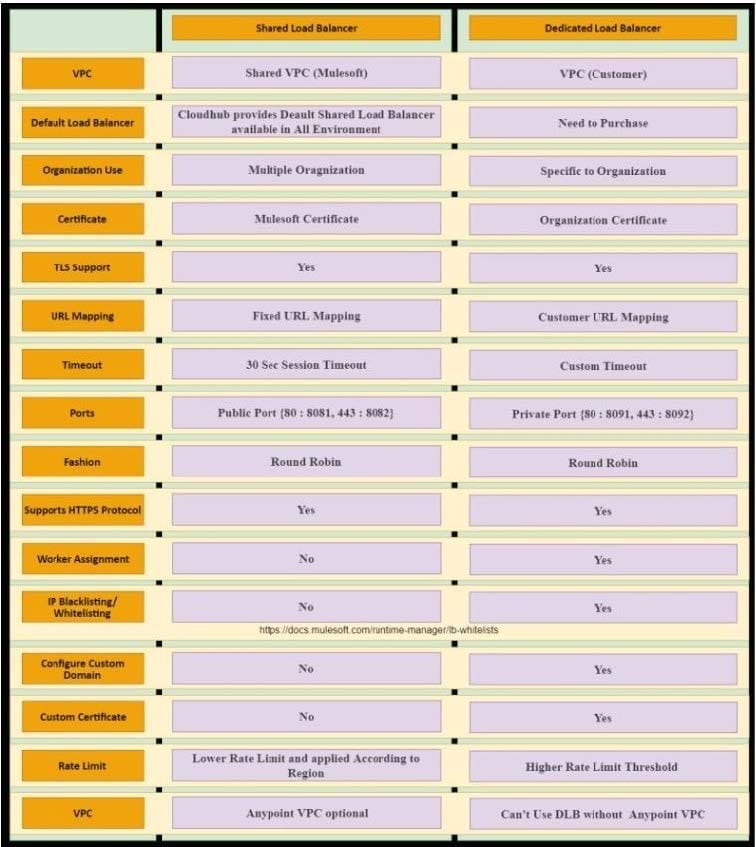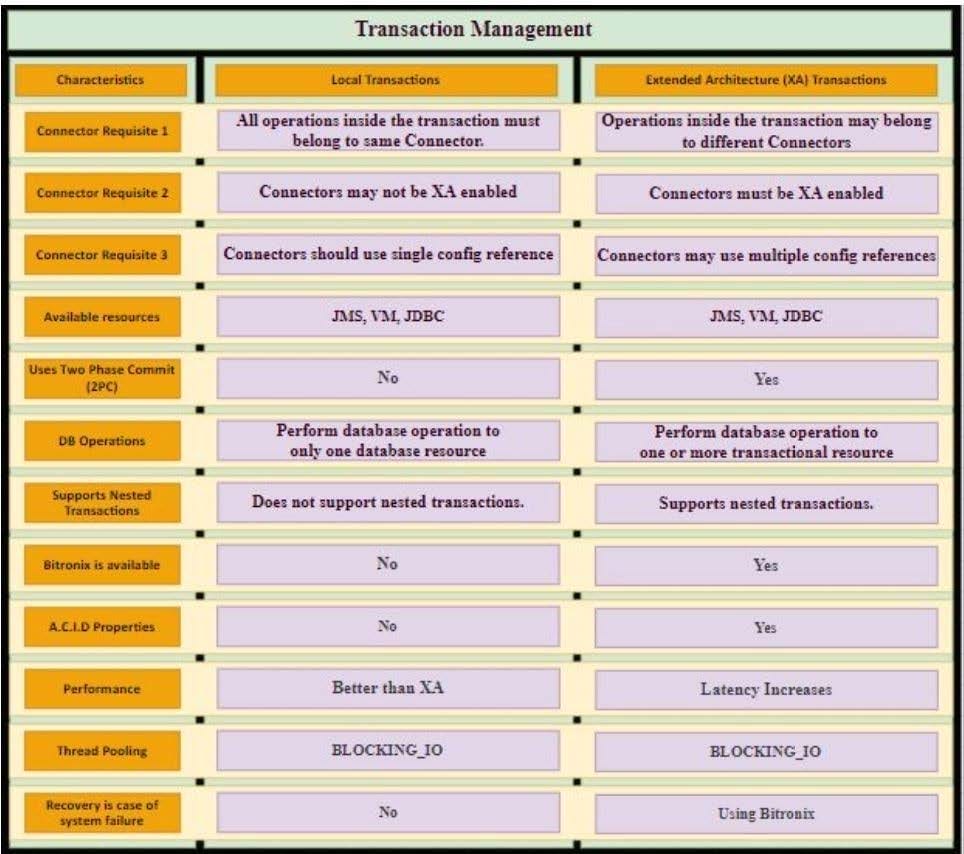MCIA-LEVEL-1 Online Practice Questions and Answers
An organization is evaluating using the CloudHub shared Load Balancer (SLB) vs creating a CloudHub dedicated load balancer (DLB). They are evaluating how this choice affects the various types of certificates used by CloudHub deployed Mule applications, including MuleSoft-provided, customer-provided, or Mule application-provided certificates. What type of restrictions exist on the types of certificates for the service that can be exposed by the CloudHub Shared Load Balancer (SLB) to external web clients over the public internet?
A. Underlying Mule applications need to implement own certificates
B. Only MuleSoft provided certificates can be used for server side certificate
C. Only self signed certificates can be used
D. All certificates which can be used in shared load balancer need to get approved by raising support ticket
An airline is architecting an API connectivity project to integrate its flight data into an online aggregation website. The interface must allow for secure communication high-performance and asynchronous message exchange. What are suitable interface technologies for this integration assuming that Mulesoft fully supports these technologies and that Anypoint connectors exist for these interfaces?
A. AsyncAPI over HTTPS AMQP with RabbitMQ JSON/REST over HTTPS
B. XML over ActiveMQ XML over SFTP XML/REST over HTTPS
C. CSV over FTP YAM L over TLS JSON over HTTPS
D. SOAP over HTTPS HOP over TLS gRPC over HTTPS
An XA transaction Is being configured that involves a JMS connector listening for Incoming JMS messages. What is the meaning of the timeout attribute of the XA transaction, and what happens after the timeout expires?
A. The time that is allowed to pass between committing the transaction and the completion of the Mule flow After the timeout, flow processing triggers an error
B. The time that Is allowed to pass between receiving JMS messages on the same JMS connection After the timeout, a new JMS connection Is established
C. The time that Is allowed to pass without the transaction being ended explicitly After the timeout, the transaction Is forcefully rolled-back
D. The time that Is allowed to pass for state JMS consumer threads to be destroyed After the timeout, a new JMS consumer thread is created
An organization has strict unit test requirement that mandate every mule application must have an MUnit test suit with a test case defined for each flow and a minimum test coverage of 80%.
A developer is building Munit test suit for a newly developed mule application that sends API request to an external rest API.
What is the effective approach for successfully executing the Munit tests of this new application while still achieving the required test coverage for the Munit tests?
A. Invoke the external endpoint of the rest API from the mule floors
B. Mark the rest API invocations in the Munits and then call the mocking service flow that simulates standard responses from the REST API
C. Mock the rest API invocation in the Munits and return a mock response for those invocations
D. Create a mocking service flow to simulate standard responses from the rest API and then configure the mule flows to call the marking service flow
Which Exchange asset type represents a complete API specification in RAML or OAS format?
A. Connectors
B. REST APIs
C. API Spec Fragments
D. SOAP APIs
A Mule application name Pub uses a persistence object store. The Pub Mule application is deployed to Cloudhub and it configured to use Object Store v2.
Another Mule application name sub is being developed to retrieve values from the Pub Mule application persistence object Store and will also be deployed to cloudhub.
What is the most direct way for the Sub Mule application to retrieve values from the Pub Mule application persistence object store with the least latency?
A. Use an object store connector configured to access the Pub Mule application persistence object store
B. Use a VM connector configured to directly access the persistence queue of the Pub Mule application persistence object store.
C. Use an Anypoint MQ connector configured to directly access the Pub Mule application persistence object store
D. Use the Object store v2 REST API configured to access the Pub Mule application persistence object store.
A Mule application currently writes to two separate SQL Server database instances across the internet using a single XA transaction. It is 58. proposed to split this one transaction into two separate non-XA transactions with no other changes to the Mule application.
What non-functional requirement can be expected to be negatively affected when implementing this change?
A. Throughput
B. Consistency
C. Response time
D. Availability
An organization is sizing an Anypoint VPC to extend their internal network to Cloudhub.
For this sizing calculation, the organization assumes 150 Mule applications will be deployed among three(3) production environments and will use Cloudhub's default zero- downtime feature. Each Mule application is expected to be configured with two(2) Cloudhub workers.This is expected to result in several Mule application deployments per hour.
A. 10.0.0.0/21(2048 IPs)
B. 10.0.0.0/22(1024IPs)
C. 10.0.0.0/23(512 IPs)
D. 10.0.0.0/24(256 IPs)
A developer needs to discover which API specifications have been created within the organization before starting a new project. Which Anypoint Platform component can the developer use to find and try out the currently released API specifications?
A. Anypoint Exchange
B. Runtime Manager
C. API Manager
D. Object Store
Refer to the exhibit.

An organization is sizing an Anypoint VPC for the non-production deployments of those Mule applications that connect to the organization's on-premises systems. This applies to approx. 60 Mule applications. Each application is deployed to
two CloudHub i workers. The organization currently has three non-production environments (DEV, SIT and UAT) that share this VPC. The AWS region of the VPC has two AZs.
The organization has a very mature DevOps approach which automatically progresses each application through all non-production environments before automatically deploying to production. This process results in several Mule application
deployments per hour, using CloudHub's normal zero-downtime deployment feature.
What is a CIDR block for this VPC that results in the smallest usable private IP address range?
A. 10.0.0.0/26 (64 IPS)
B. 10.0.0.0/25 (128 IPs)
C. 10.0.0.0/24 (256 IPs)
D. 10.0.0.0/22 (1024 IPs)

